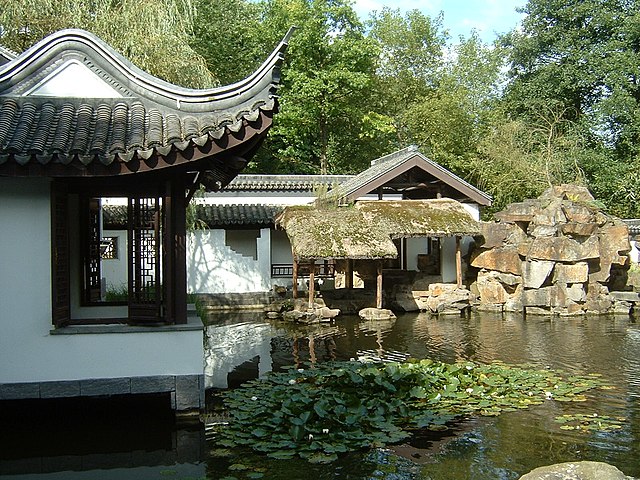Loading AI tools
Public university in Germany From Wikipedia, the free encyclopedia
The Ruhr University Bochum (German: Ruhr-Universität Bochum, RUB) is a public research university located in the southern hills of the central Ruhr area, Bochum, Germany. It was founded in 1962 as the first new public university in Germany after World War II. Instruction began in 1965.
Ruhr-Universität Bochum | |
 | |
| Motto | menschlich – weltoffen – leistungsstark[1] |
|---|---|
Motto in English | Humane – Cosmopolitan – Capable |
| Type | Public |
| Established | 1962 |
| Budget | € 539.1 million[2] |
| Rector | Martin Paul[3] |
Academic staff | 3,324[4] |
Administrative staff | 2,378[4] |
| Students | 42,425[4] |
| Undergraduates | 22,458[5] |
| Postgraduates | 9,814[5] |
| 3,619[5] | |
Other students | 7,223 international students[6] |
| Location | , , Germany 51°26′38″N 7°15′42″E |
| Campus | Urban/Suburban Campus area 4.5 sq.km[7] |
| Colors | RUB-Blau, RUB-Grün |
| Affiliations | UARuhr, DAAD, DFG, Utrecht Network, UNIC Network, MAUI Network, AEN Network, NOHA Network |
| Website | www.ruhr-uni-bochum.de |
The Ruhr-University Bochum is one of the largest universities in Germany and part of the Deutsche Forschungsgemeinschaft, the most important German research funding organization.[8]
The RUB was very successful in the Excellence Initiative of the German Federal and State Governments (2007), a competition between Germany's most prestigious universities. It was one of the few institutions left competing for the title of an "elite university", but did not succeed in the last round. There are currently nine universities in Germany that hold this title.
The University of Bochum was one of the first universities in Germany to introduce international bachelor's and master's degrees, which replaced the traditional German Diplom and Magister. Except for a few special cases, such as law, these degrees are offered by all faculties of the Ruhr-University. Currently, the university offers a total of 184 different study programs from all academic fields represented at the university.[9]



Unlike many older German universities, the buildings of Ruhr-University are all centralized on one campus, located south of Bochum city. The Faculty of Medicine includes several university clinics that are located at different centres in Bochum and the Ruhr area. A major facility for patient care is the University Hospital/Knappschaftskrankenhaus in the district Langendreer of Bochum. Internationally renowned experts in their respective fields include professors Wolff Schmiegel in oncology and Burkhard Dick in ophthalmology. The centralized university campus architecture is comprised almost exclusively of the 1960s architecture style referred to as Brutalism, consisting of 14 almost identical high-rise buildings. One striking feature of these buildings is that although their roofs are all at the same apparent height (sky level), the absolute heights of the buildings vary in accordance with their placement on the undulating landscape in which the university is located: the campus is at the edge of a green belt on high ground adjacent to the Ruhr valley.
The arrangement of the buildings and the (concrete) paths and bridges between them was originally meant to resemble a "harbour of knowledge", with the buildings symbolising vessels, by architect Helmut Hentrich.[10]
The campus has undergone heavy modernisation and extension efforts, including the construction and refurbishment of several buildings.[11] Some of the original 1960s buildings are to be rebuilt, instead of refurbished, due to PCB contamination.[12] The overall campus concept envisions a modern facility[13] and the placement of Bochum as a "knowledge city".[14]
Ruhr-University is financed and administered by the state of North Rhine-Westphalia. Currently, 42,718 students are enrolled, and the university employs around 5,600 staff (411 of which are professors),[15] making it one of the ten largest universities in Germany as of 2014. Kurt Biedenkopf, who later became prime minister of the state of Saxony, was rector of the university from 1967 to 1969.
The university is organized into twenty-one different faculties. These are:[16]
ECUE - European Culture and Economy
In the QS World University Rankings for 2024, the university was ranked 375th globally and 20th nationally.[18] Meanwhile, the Times Higher Education World University Rankings for 2024 positioned the university in a range between 251st and 300th worldwide, and between 25th and 31st in the national ranking.[19] Similarly, in the 2023 ARWU list, the university placed between 301st and 400th globally and between 20th and 24th nationally.[20]
|
| |||||||||||||||||||||||||||||||||||||||||||||||||||||||||||||||||||||||||||||||||||||||||||||||||||||||||||||||||||||||||||||||||||||||||||||||||||
This section needs expansion. You can help by adding to it. (February 2020) |
Seamless Wikipedia browsing. On steroids.
Every time you click a link to Wikipedia, Wiktionary or Wikiquote in your browser's search results, it will show the modern Wikiwand interface.
Wikiwand extension is a five stars, simple, with minimum permission required to keep your browsing private, safe and transparent.